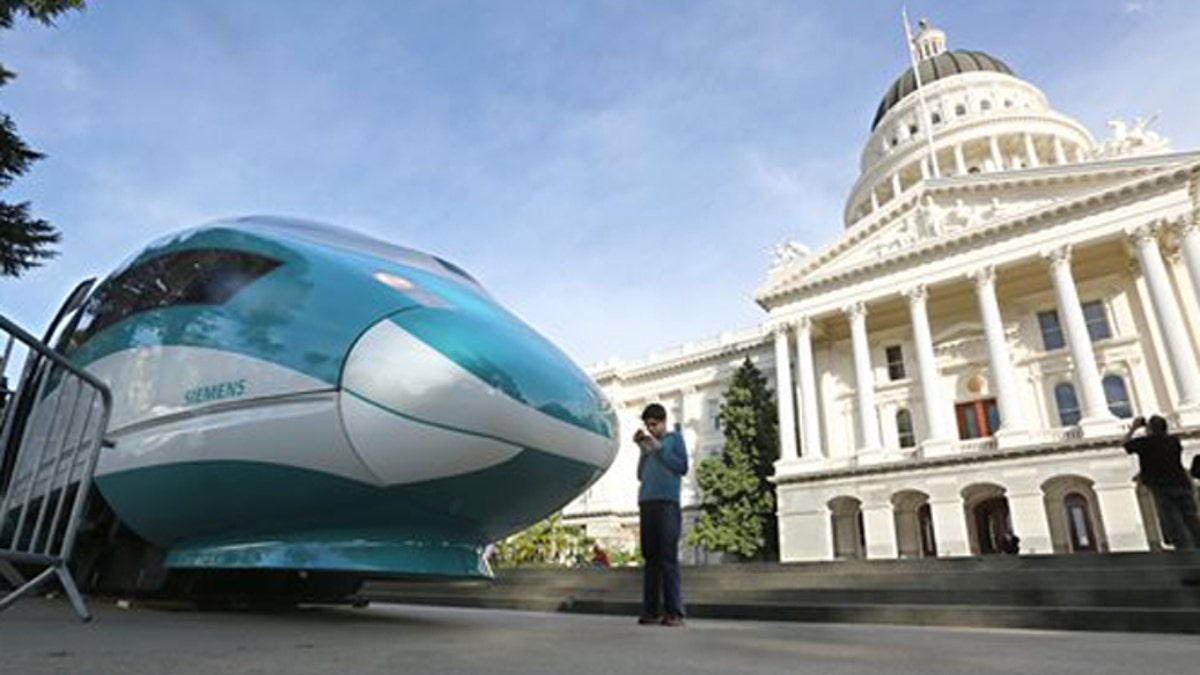
FILE - In this Feb. 26, 2015 file photo, a full-scale mock-up of a high-speed train is displayed at the Capitol in Sacramento, Calif. State officials will return to Sacramento Superior Court, Thursday, Feb. 11, 2016, to defend the project against critics who say high-speed rail cannot meet promises made to voters who approved a $9.9 billion bond measure to build it. (AP Photo/Rich Pedroncelli, File)
SACRAMENTO, Calif. – California voters embraced the idea of building the nation's first real high-speed rail system, which promised to whisk travelers from San Francisco to Los Angeles in under three hours, a trip that can take six hours or more by car. Eight years after they approved funding for it, construction is years behind schedule and legal, financial and logistical delays plague the $68 billion project.
The bullet train's timeline, funding and speed estimates are back in the spotlight for a longstanding lawsuit filed by residents whose property lies in its path.
In the second phase of a court challenge filed in 2011, attorneys for a group of Central Valley farmers will argue in Sacramento County Superior Court on Thursday that the state can't keep the promises it made to voters in 2008 about the travel times and system cost. Voters authorized selling $9.9 billion in bonds for a project that was supposed to cost $40 billion.
In recent months, rail officials have touted construction of a viaduct in Madera County, the first visible sign of construction. Though officials have been working for years to acquire the thousands of parcels of land required for the project, they currently have just 63 percent of the parcels needed for the first 29 miles in the Central Valley.
And as planning continues, opposition has mounted in Southern California, where bullet train officials are weighing four potential routes.
"You can't build a 520-mile system like this and not have some impacts somewhere," said Dan Richard, chairman of the politically appointed board that oversees the rail project. He said officials have tried to work with community leaders to solve problems when they arise.
Money remains the biggest challenge, but there are political hurdles, too.
As part of a deal with the Legislature to secure funding from California's fee on polluters, Gov. Jerry Brown's administration agreed to extend the rail system south to Burbank before it heads north. But at a recent legislative hearing, rail officials indicated that they may reverse course when the rail authority releases its new business plan later in February.
On the money side, California has the voter-approved bonds, $2.5 billion in federal stimulus funds that must be spent by September 2017 and a quarter of fluctuating revenues from the state's cap-and-trade program, which could eventually hit $500 million a year. Each of those funding sources carries political and legal risks, the state's independent legislative analyst has noted.
"What people are now talking about is we're going to end up with a 130-mile mound of dirt. They're going to run out of money sometime by 2017," said Stuart Flashman, an attorney who represents the plaintiffs in the lawsuit against the state. "At that point they're not even going to be starting laying tracks. They're certainly not going to be having anything usable for trains."
The board chairman, Richard, said this month that the upcoming business plan could lower the project's overall cost, as the authority has inked contracts at lower-than-expected rates.
In responses solicited by the rail project, private companies earlier this year indicated strong interest in construction, supplying infrastructure such as train cars and operating the line. But virtually none said they were willing to take the financial risk until passengers are actually riding, which won't happen until at least 2022.
Also, an independent peer review group that oversees California high-speed rail added: "It is not uncommon for most new services to face initial losses, which could conflict with another mandate in the bond financing that states the rail service would not require an 'operating subsidy.''"
Other terms of that initiative also will be before Superior Court Judge Michael Kenny this week. A group of landowners in the Central Valley filed suit over the project, arguing that compromises made to cut the price mean the train won't be able to travel from San Francisco to Los Angeles in two hours and 40 minutes as voters were told. Critics argue trains cannot traverse the steep Tehachapi Mountains in Southern California at the necessary 220mph.
"I have never had one of our engineers or anybody come to me and say we're not going to be able to make the 2:40," Richard said. "We are committed to it, that is the law, that's what we're building."
Kenny previously ruled in favor of the plaintiffs, agreeing the state had failed to meet the mandates that it identify funding for the first useable segment before starting construction and have all the needed environmental clearances in hand. But an appeals court reversed the ruling, saying the lawsuit was premature.
Political winds could be shifting, too, depending on the details of the rail authority's anticipated business plan.
Republicans in the Legislature have always opposed the project, and support among Democrats has sometimes been tepid, though the Democratic governor has been a consistent advocate.
Assembly Speaker Toni Atkins, D-San Diego, has promised "a broader range of oversight actions in 2016" on high-speed rail, which will include a hearing next month by the Assembly Transportation Committee.





















